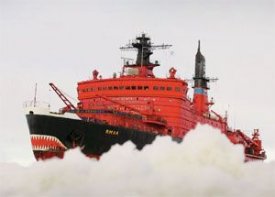New Container Shipping and Bulk Freight Carrier Route Poses Unusual Questions

CHINA – ARCTIC – EUROPE – RUSSIA – US – WORLDWIDE – Our story on Sunday regarding a terrorist attack on a container ship transiting the Suez Canal may have repercussions which affect the way the shipping community view a route far to the north, yet which might have a direct bearing on the future of traffic previously bound to pass between the Mediterranean and Red Seas. The current voyage of the state owned Chinese multi-purpose freight vessel,Yong Sheng, due to arrive in the Netherlands in a week’s time, has already engendered much interest, being that nation’s first truly commercial transit via the Arctic Northern Sea Route (NSR).
The Cosco ship, whilst not specifically a container vessel, will save around 2,400 miles and almost a fortnight by using the Arctic route, but the region is fraught with dangers, both physical and economic. The retreat and return of the ice is both variable and unpredictable, each year the patterns shift both chronologically and geographically whilst historically the route, all of which lies in Arctic waters, is rarely clear enough for safe navigation for more than two months in any year.
The NSR, which was formerly known as the Northeast Passage to distinguish it from its more commonly known sister route, the Northwest Passage, runs between the Pacific and Atlantic Oceans, from the Far East through the narrows of the Bering Strait into the East Siberian Sea and along the coastline into the Barents Sea and onward to Murmansk and beyond. There have been numerous voyages along its course but except for the odd one such as the west to east transit of an LNG carrier last year, these have been mostly non commercial operations or ‘one off’ deliveries by induced charter vessels.
We have written before on various expeditions via the most northerly of routes, including the successful voyages undertaken by the now defunct Beluga operation and the forecast, in 2009, that we would see the NSR as a regular route for parts of the year ‘within a decade’. We also made mention that there would likely be political problems, whilst on the credit side vessels would be able to avoid certain pirate hotspots.
Now, with the world’s sixth biggest container line seemingly taking the route as a serious option, there may have to be a rethink by other sectors of the logistics associated industries. Insurance alone may provide an interesting conundrum for different stakeholders. Whilst our enquiries amongst the P&I community prompted a response that routes were not really material to the risks they provided against, there are points for and against travelling in the colder regions.
Enquiries made to London brokers who deal with a variety of maritime risks, from hull cover to goods in transit, elicited a muted response saying that every case would have to be dealt with ‘on its own merits’ leaving one to wonder whether the reduction in risk from terrorist attack, something which normally requires separate insurance, would equate in cost to any extra risks incurred by the perils of the new route, such as the need for rescue from the ice.
The Chinese have set great store by the fact that the Russians apparently allowed them to provide their own icebreaker cover for the three trips which they have reportedly been allowed to undertake after gaining permission from the Russian North Sea Route Administration, following completion of anapplication procedure which it is essential to conform to prior to undertaking any voyage in the region.
The Xuě Lóng, is a Chinese icebreaker which caused controversy in 1999 when it appeared, undetected and unannounced, at a small, isolated Canadian Arctic coastal settlement, starting an internal debate about Canada’s security. The ship, which last year made the complete transit via the NSR however is diesel powered with a 17,700 HP engine and does not match the current fleet of Russian atomic powered ‘breakers which might be necessary to enable the safe passage, or even rescue, of ships becoming trapped in the ice. Our photo shows the 75,000HP nuclear icebreaker Yamal, and a look at the website of Rosatom Flot, the state owned operator makes Russian intentions for the region very obvious.
More vessels using the new route will undoubtedly mean more work for the Russian fleet which keeps the waterway clear but the US it seems also has an eye on possibilities for maritime traffic in the region, despite likely environmental, and possibly political, concerns. In May the U.S. Army Corps of Engineers announced its intention to launch an ‘Arctic Deep Draft Ports Navigation Improvements Feasibility Study’. The intention is to improve maritime infrastructure in the vicinity of Norton Sound and the Bering Strait and beyond, as a direct result of increasing sea borne traffic as climate change causes an increase in commercial shipping.
The latest study resulted from a recommendation in the final Alaska Deep Draft Arctic Port System Study published in March, and is a partnership between the Corps and Alaska Department of Transportation and Public Facilities. Public meetings were held to explain the government’s possible intentions to local residents and it was explained that of the fourteen sites initially considered for infrastructure improvements in the port system study, the Nome and Port Clarence areas with their naturally deep waters seemed to be the most likely sites for serving as deep draft harbours. The final report as to the intentions of the US to develop the area is expected in December and there are talks of infrastructure development as soon as 2017.
US interest is driven by the White House’s National Strategy for the Arctic Region, also published in May and outlining policy with regard to the country’s intentions, particularly for Alaska, which holds immense mineral wealth, currently underexploited due to the difficulties in marketing following extraction. A strategically situated deep water port could change that picture entirely and see bulk freighter, as well as container traffic, passing along the NSR at a dramatically increased level.
Somewhat ironically, for all this talk, Nature may well still have the last word. Amongst volumes devoted to the reality and causation of climate change and global warming the fact remains that ice and gales in the Bering Sea and further east this year have been amongst the worst in living memory. Perhaps the NSR should be viewed as a route of opportunity rather than something carved into the stone of any shipping company service schedules, at least for the foreseeable future.

